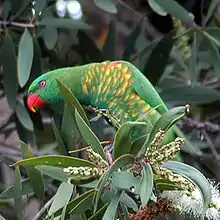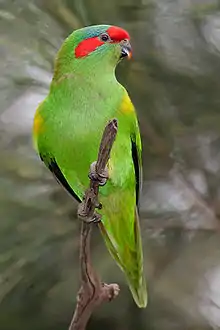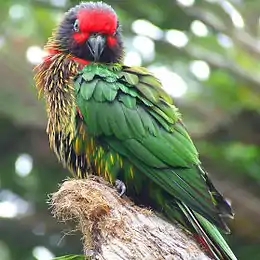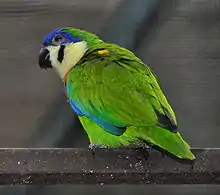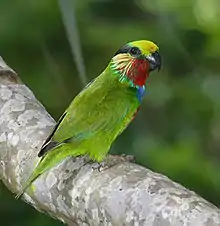Loriinae
Loriinae is a subfamily of psittacine birds, one of the five subfamilies that make up the family Psittaculidae. It consists of three tribes, the lories and lorikeets (Loriini), the budgerigar (Melopsittacini) and the fig parrots (Cyclopsittini), which are small birds, mostly of bright colors and inhabitants of Oceania and the islands of Southeast Asia.
| Loriinae | |
|---|---|
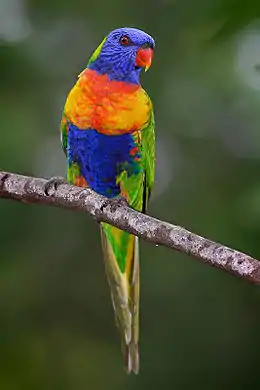 | |
| Rainbow lorikeet (T. m. moluccanus) | |
| Scientific classification | |
| Kingdom: | Animalia |
| Phylum: | Chordata |
| Class: | Aves |
| Order: | Psittaciformes |
| Family: | Psittaculidae |
| Subfamily: | Loriinae Selby, 1836 |
| Tribes | |
Taxonomy
Traditionally it was considered that the lories were the only members of the subfamily Loriinae, or were integrated into their own family, Loriidae,[1] but currently they are classified as a tribe, Loriini, within a larger subfamily Loriinae. The genetic studies showed that the lories are closely related to the budgerigar and the fig parrots of the genera Cyclopsitta and Psittaculirostris,[2][3][4][5][6] that form the other two tribes that make up the subfamily, Melopsittacini and Cyclopsittini, respectively. Loriinae is integrated as one of the five subfamilies of the family Psittaculidae, together with Psittaculinae, Platycercinae, Psittacellinae, Agapornithinae; and in turn Psittaculidae forms together with two families more the superfamily Psittacoidea.
Genera
The following most recent classification, based on the most relevant research in the field.[7][2][4][8][9][10]
Tribe Cyclopsittini:
- Genus Cyclopsitta
- Orange-breasted fig parrot, Cyclopsitta gulielmitertii
- Double-eyed fig parrot, Cyclopsitta diophthalma
- Genus Psittaculirostris
- Large fig parrot, Psittaculirostris desmarestii
- Edwards's fig parrot, Psittaculirostris edwardsii
- Salvadori's fig parrot, Psittaculirostris salvadorii
Tribe Loriini:
- Genus Chalcopsitta
- Black lory, Chalcopsitta atra
- Brown lory, Chalcopsitta duivenbodei (also called Duyvenbode's lory)
- Yellowish-streaked lory, Chalcopsitta sintillata
- Genus Eos
- Black-winged lory, Eos cyanogenia
- Violet-necked lory, Eos squamata
- Blue-streaked lory, Eos reticulata
- Red-and-blue lory, Eos histrio
- Red lory, Eos bornea
- Blue-eared lory, Eos semilarvata
- Genus Pseudeos
- Dusky lory, Pseudeos fuscata
- Cardinal lory, Pseudeos cardinalis
- Genus Trichoglossus
- Ornate lorikeet, Trichoglossus ornatus (also called ornate lory)
- Sunset lorikeet, Trichoglossus forsteni (also called scarlet-breasted lorikeet)
- Leaf lorikeet, Trichoglossus weberi (also called Flores lorikeet)
- Marigold lorikeet, Trichoglossus capestratus
- Coconut lorikeet, Trichoglossus haematodus
- Biak lorikeet, Trichoglossus rosenbergi
- Rainbow lorikeet, Trichoglossus moluccanus
- Red-collared lorikeet, Trichoglossus rubritorquis
- Olive-headed lorikeet, Trichoglossus euteles (also called Perfect lorikeet)
- Citrine lorikeet, Trichoglossus flavoviridis
- Mindanao lorikeet, Trichoglossus johnstoniae (also called Johnstone's lorikeet)
- Pohnpei lorikeet, Trichoglossus rubiginosus (also called Ponape lory)
- Scaly-breasted lorikeet, Trichoglossus chlorolepidotus
- Genus Psitteuteles (sometimes classified in the genus Trichoglossus)
- Varied lorikeet, Psitteuteles versicolor
- Iris lorikeet, Psitteuteles iris
- Goldie's lorikeet, Psitteuteles goldiei
- Genus Lorius
- Purple-bellied lory, Lorius hypoinochrous (synonym Stresemann's lory, Lorius amabilis)[11]
- Black-capped lory, Lorius lory
- White-naped lory, Lorius albidinuchus
- Yellow-bibbed lory, Lorius chlorocercus
- Purple-naped lory, Lorius domicellus (synonym blue-thighed lory, Lorius tibialis)[12]
- Chattering lory, Lorius garrulus
- Genus Phigys
- Collared lory, Phigys solitarius
- Genus Vini
- Blue-crowned lorikeet, Vini australis
- Kuhl's lorikeet, Vini kuhlii
- Stephen's lorikeet, Vini stepheni
- Blue lorikeet, Vini peruviana
- Ultramarine lorikeet, Vini ultramarina
- †Sinoto's lorikeet, Vini sinotoi (extinct)
- †Conquered lorikeet, Vini vidivici (extinct)
- Genus Glossopsitta
- Musk lorikeet, Glossopsitta concinna
- Genus Parvipsitta
- Little lorikeet, Parvipsitta pusilla
- Purple-crowned lorikeet, Parvipsitta porphyrocephala
- Genus Charmosyna
- Palm lorikeet, Charmosyna palmarum
- Red-chinned lorikeet, Charmosyna rubrigularis
- Meek's lorikeet, Charmosyna meeki
- Blue-fronted lorikeet, Charmosyna toxopei
- Striated lorikeet, Charmosyna multistriata
- Pygmy lorikeet, Charmosyna wilhelminae (also called Wilhelmina's lorikeet)
- Red-fronted lorikeet, Charmosyna rubronotata (also called red-spotted lorikeet)
- Red-flanked lorikeet, Charmosyna placentis
- †? New Caledonian lorikeet, Charmosyna diadema (possibly extinct, 20th Century?)
- Red-throated lorikeet, Charmosyna amabilis
- Duchess lorikeet, Charmosyna margarethae
- Fairy lorikeet, Charmosyna pulchella
- Josephine's lorikeet, Charmosyna josefinae (also called Josephine's lory)
- Papuan lorikeet, Charmosyna papou (also called Papuan lory)
- Genus Oreopsittacus
- Plum-faced lorikeet, Oreopsittacus arfaki (also called Whiskered lorikeet)
- Genus Neopsittacus
- Yellow-billed lorikeet, Neopsittacus musschenbroekii (also called Musschenbroek's lorikeet)
- Orange-billed lorikeet, Neopsittacus pullicauda (also called Emerald lorikeet)
Tribe Melopsittacini:
- Genus Melopsittacus
- Budgerigar, Melopsittacus undulatus (also called common parakeet or shell parakeet, they kind of look like rosellas)
References
- Forshaw, Joseph M.; Cooper, William T. (1981) [1973, 1978]. Parrots of the World (corrected second ed.). David & Charles, Newton Abbot, London. ISBN 0-7153-7698-5.
- Wright, T.F.; Schirtzinger E. E.; Matsumoto T.; Eberhard J. R.; Graves G. R.; Sanchez J. J.; Capelli S.; Muller H.; Scharpegge J.; Chambers G. K.; Fleischer R. C. (2008). A Multilocus Molecular Phylogeny of the Parrots (Psittaciformes): Support for a Gondwanan Origin during the Cretaceous. Molecular Biology and Evolution. 25. Mol Biol Evol. pp. 2141–2156. doi:10.1093/molbev/msn160. PMC 2727385. PMID 18653733.
- Astuti, Dwi; Azuma, Noriko; Suzuki, Hitoshi; Higashi, Seigo (2006). "Phylogenetic relationships within parrots (Psittacidae) inferred from mitochondrial cytochrome-b gene sequences". Zoological Science. 23 (2): 191–98. doi:10.2108/zsj.23.191. hdl:2115/54809. PMID 16603811. S2CID 35879495.
- de Kloet, RS; de Kloet SR (2005). "The evolution of the spindlin gene in birds: Sequence analysis of an intron of the spindlin W and Z gene reveals four major divisions of the Psittaciformes". Molecular Phylogenetics and Evolution. 36 (3): 706–721. doi:10.1016/j.ympev.2005.03.013. PMID 16099384.
- Tokita, Masayoshi; Kiyoshi, Takuya; Armstrong, Kyle N. (30 October 2007). "Evolution of craniofacial novelty in parrots through developmental modularity and heterochrony". Evolution & Development. 9 (6): 590–601. doi:10.1111/j.1525-142X.2007.00199.x. PMID 17976055. S2CID 46659963.
- Christidis, L; Schodde, R; Shaw, D. D; Maynes, S. F (1991). "Relationships among the Australo-Papuan Parrots, Lorikeets, and Cockatoos (Aves: Psittaciformes): Protein Evidence". Condor. 93 (2): 302–17. doi:10.2307/1368946. JSTOR 1368946.
- Joseph, L.; Toon, A.; Schritzinger, E. E.; Wright, T. F.; Schodde, R (2012). "A revised nomenclature and classification for family-group taxa of parrots (Psittaciformes)" (PDF). Zootaxa. 3205: 26–40. doi:10.11646/zootaxa.3205.1.2.
- Schweizer, Manuel; Seehausen, Ole; Hertwig, Stefan T. (2011). "Macroevolutionary patterns in the diversification of parrots: effects of climate change, geological events and key innovations". Journal of Biogeography. 38 (11): 2176–2194. doi:10.1111/j.1365-2699.2011.02555.x.
- Joseph, Leo; Toon, Alicia; Schirtzinger, Erin E.; Wright, Timothy F. (2011). "Molecular systematics of two enigmatic genera Psittacella and Pezoporus illuminate the ecological radiation of Australo-Papuan parrots (Aves: Psittaciformes)". Molecular Phylogenetics and Evolution. 59 (3): 675–684. doi:10.1016/j.ympev.2011.03.017. PMID 21453777.
- Schweizer, Manuel; Seehausen, Ole; Güntert, Marcel; Hertwig, Stefan T. (March 2010). "The evolutionary diversification of parrots supports a taxon pulse model with multiple trans-oceanic dispersal events and local radiations". Molecular Phylogenetics and Evolution. 54 (3): 984–994. doi:10.1016/j.ympev.2009.08.021. PMID 19699808.
- "UNEP-WCMC Species Database Lorius amabilis". Unep-wcmc.org. Retrieved 2013-02-09.
- "UNEP-WCMC Species Database Lorius tibialis". Unep-wcmc.org. Retrieved 2013-02-09.

